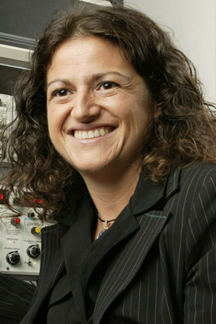Researchers Show Protein Linked to Hunger Also Implicated in Alcoholism
By Kendall Powell and Mika Ono
Researchers at The Scripps Research Institute have found new links between a protein that controls our urge to eat and brain cells involved in the development of alcoholism. The discovery points to new possibilities for designing drugs to treat alcoholism and other addictions.
The new study, published online ahead of print by the journal Neuropsychopharmacology, focuses on the peptide ghrelin, which is known to stimulate eating.
“This is the first study to characterize the effects of ghrelin on neurons in a brain region called the central nucleus of the amygdala,” said team leader Scripps Research Institute Associate Professor Marisa Roberto, who was knighted last year by the Italian Republic for her work in the alcoholism field. “There is increasing evidence that the peptide systems regulating food consumption are also critical players in excessive alcohol consumption. These peptide systems have the potential to serve as targets for new therapies aimed at treating alcoholism.”
Excessive alcohol use and alcoholism cause approximately 4 percent of deaths globally each year. In the United States, that translates to 79,000 deaths annually and $224 billion in healthcare and other economic costs, according to a 2011 report by the Centers for Disease Control and Prevention.
Key Brain Region
The brain region known as the central nucleus of the amygdala is thought to be a key region in the transition to alcohol dependence, that is, a biological change from experiencing a pleasant sensation upon the consumption of alcohol to the need to consume alcohol to relieve unpleasant, negative feelings due to the lack of its consumption. In animals addicted to alcohol, the central nucleus of the amygdala controls increased consumption.
“Given the importance of the central nucleus of the amygdala in alcohol dependence, we wanted to test ghrelin’s effects in this region,” said Maureen Cruz, the first author of the study and former research associate in the Roberto laboratory, now an associate at Booz Allen Hamilton in Rockville, MD.
The peptide ghrelin is best known for stimulating eating through its action on a receptor known as GHSR1A in the hypothalamus region of the brain. But scientists had recently shown that gene defects in both ghrelin and the GHSR1A receptor were associated with severe cases of alcoholism in animal models. In addition, alcoholic patients have higher levels of the ghrelin peptide circulating in their blood compared to non-alcoholic patients. And, the higher the ghrelin levels, the higher the patients’ reported cravings for alcohol.
New Evidence
In the new study, Roberto, Cruz, and colleagues at Scripps Research and the Oregon Health and Sciences University first demonstrated that GHSR1A is present on neurons in the central nucleus of the amygdala in the rat brain.
Using intracellular recording techniques, the team then measured how the strength of the GABAergic synapses (the area between neurons transmitting the inhibitory neurotransmitter GABA) changed when ghrelin was applied. They found that ghrelin caused increased GABAergic transmission in the central amygdala neurons. With further testing, the scientists determined that most likely this was due to increased release of the GABA neurotransmitter.
Next, the researchers blocked the GHSR1A receptor with a chemical inhibitor and measured a decrease in GABA transmission. This revealed tonic, or continuous, ghrelin activity in these neurons.
In the final set of experiments, the researchers examined neurons from alcohol-addicted and control rats when both ghrelin and ethanol were added. First, the scientists added ghrelin followed by ethanol. This resulted in an even stronger increase in GABAergic responses in these neurons. However, when the scientists reversed the order, adding ethanol first and ghrelin second, ghrelin did not further increase GABAergic transmission. This suggests that ghrelin could be potentiating the effects of alcohol in the central nucleus of the amygdala, in effect, priming the system.
New Possibilities
“Our results point to both shared and different mechanisms involved in the effects of ghrelin and ethanol in the central nucleus of the amygdala,” said Roberto. “Importantly, there is a tonic ghrelin signal that appears to interact with pathways activated by both acute and chronic ethanol exposure. Perhaps if we could find a way to block ghrelin’s activity in this region, we could dampen or even turn off the cravings felt by alcoholics.”
Roberto cautions, though, that current therapies for alcoholism only work in a subset of patients.
“Because alcohol affects a lot of systems in the brain, there won’t be a single pill that will cure the multiple and complex aspects of this disease,” she said. “That is why we are studying alcoholism from a variety of angles, to understand the different brain targets involved.”
In addition to Roberto and Cruz, authors of the paper, “Ghrelin Increases GABAergic Transmission and Interacts with Ethanol Actions in the Rat Central Nucleus of the Amygdala,” were Melissa Herman of Scripps Research and Dawn Cote and Andrey Ryabinin of Oregon Health and Science University. For more information, see http://www.nature.com/npp/journal/vaop/ncurrent/full/npp2012190a.html
This research was supported by the Pearson Center for Alcoholism and Addiction Research and the U.S. National Institute on Alcohol Abuse and Alcoholism (grants AA015566, AA06420, AA016985, AA017447, AA016647, AA013498 and AA010760).
Send comments to: press[at]scripps.edu














